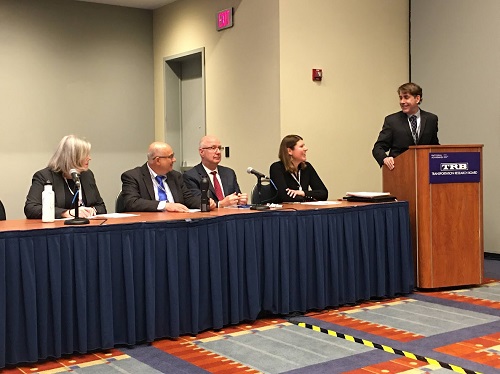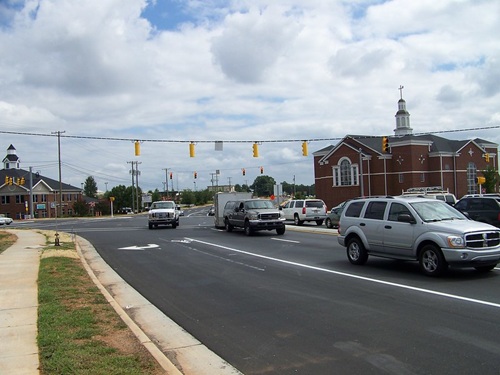A special “workshop session” at the Transportation Research Board’s 2024 Annual Meeting in Washington, D.C., aimed to elicit the key elements going into the design and makeup of the transportation agency of the future.
[Above photo by AASHTO]
That workshop featured two panels – one led by John Kaliski, vice president of Cambridge Systematics, and the other by Shailen Bhatt, administrator of the Federal Highway Administration – that included both current and former state department of transportation leaders from across the country.

“This is a topic I am particularly passionate about,” noted Victoria Sheehan, TRB’s executive director and a past president of the American Association of State Highway and Transportation Officials from New Hampshire. “The key is putting people at the center of this conversation about mobility needs of the future.”
She said that several “future focus” efforts have been initiated in parallel at the federal, state, and even some cases at the local level across the country. “We are seeing a lot of recurring themes across the guiding documents of each group developing these roadmaps for the future; it is uncanny, even, how similar the graphics are,” Sheehan noted. “We also a need to educate others about the criticality of our transportation systems and the funding decisions that will impact how we invest in our transportation systems.”
Kirk Steudle, president of the Steudle Executive Group, expressed “excitement” about how all of these “transportation agencies of the future” planning endeavors at the federal, state, and local levels are converging.
“So many plans that started independently are now coming together,” explained Steudle, a past AASHTO president from Michigan.
“From the state perspective, it is all about community-centered transportation – and forming partnerships between state DOTs and other public, private, and civic organizations to make the transportation system safe, accessible, affordable, reliable, and sustainable into the future,” he explained. “It places a focus on the customer, with technology as a key enabler. Partnerships are extremely critical, too, as that will result in a bunch of small solutions adding up to big changes, with individual and collective actions moving things forward.”

Christos Xenophontos, assistant director for administrative services for the Rhode Island Department of Transportation, noted that in the past, “incremental steps along the way” are what led to transportation changes. “But now a revolution is taking place – we are electrifying transportation and connecting systems with artificial intelligence,” he said. “We are also looking at ‘megatrends’ such as climate change, migration, globalization, urbanization, and shared economies – and how all of that impacts transportation.”
Xenophontos added that placing people and society at the “core of our activity” as transportation agencies is part of the recognition of the important role mobility infrastructure plays for individuals and society as a whole.
“We have to stop defining transportation agencies by the assets we own and, instead, by the services we offer,” he stressed. “Because if we do not manage change, change will manage us.”
Deanna Belden – director of performance, risk, and investment analysis at Minnesota Department of Transportation – added that agencies need to attract into their operations the diversity that exists in thee societies they serve as a whole.
“We need to reinforce the purpose, dignity, and culture of our workforce and the work we conduct for both movement of people and goods,” she said. “We have to anticipate complexity and change – especially customer reaction to change. That means prioritizing investments into young professionals; into diversity, equity, and inclusion programs; and find ways to boost innovation and sustainable mobility. We also have to recognize that the goals we want to achieve now are not all within our sphere of influence – so we will need to coordinate with different partners to reach those goals.”
Meghan Haggerty, chief administrative officer for the highway division at the Massachusetts Department of Transportation, stressed that the other challenge faced by mobility leaders going forward is how to balance the “daily firefighting” that goes in running a transportation system while maintaining a focus on the future.
“I for one don’t do all of it,” she explained “I am big fan of having someone focused on the crisis on the moment, and then someone else focused on where we need to go in the future. Myself, I am going to spend 20 to 30 percent of my time on the issues of the day and then focus on the top issues of the future: dealing with workforce capacity; attracting eager, younger, and diverse workers into our agency; and leveraging new technology.”
Jannine Miller – director of planning at the Georgia Department of Transportation – noted that as part of the “transformation for the future,” state DOTs need to make sure they are “living, breathing” organizations able to adapt to daily operating needs as well as future planning needs.
“It is about having the right people – and that includes the people outside our organization,” she noted. “Our external advisers, our consultants, play a key role. It is all about finding the right people to match what you want to achieve, who have a record of achieving what you want to achieve, and a firm understanding of the final end goal that we all want to achieve together. That requires clarity of purpose and mission, flexibility, and then empowering the folks with work within those structures. It is also important to think, work, and collaborate on all of this in a non-partisan way, because we are all aiming for the same objectives.”
 Top Stories
Top Stories


